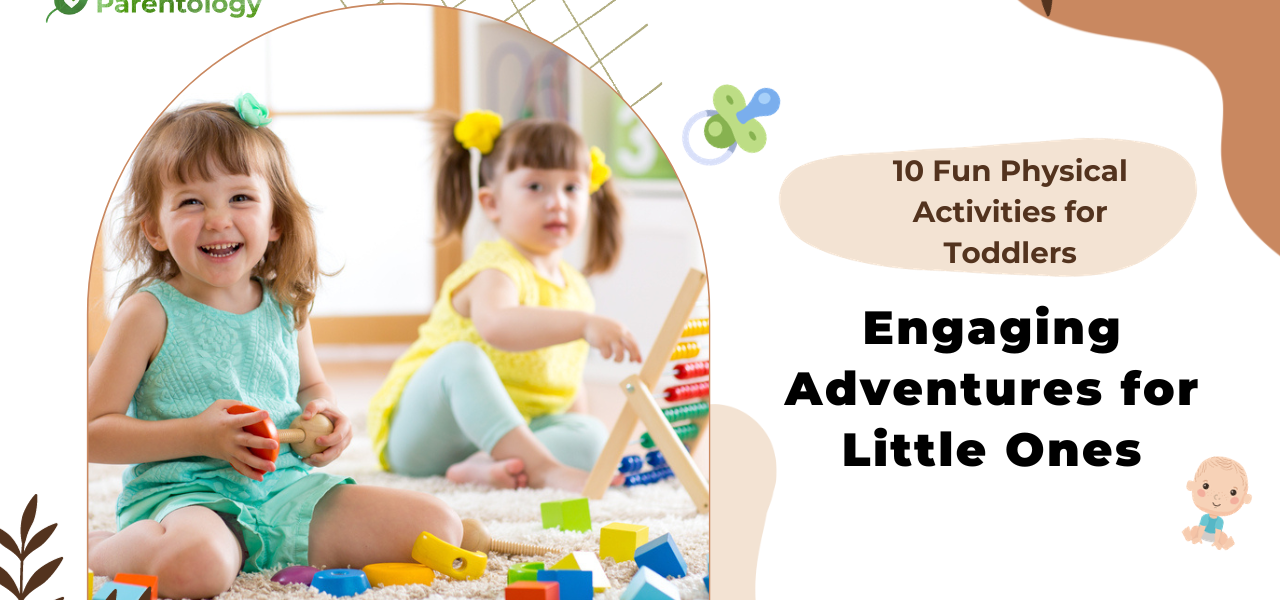10 Fun Physical Activities For Toddlers
Toddlers, in their lively and curious stage, are constantly exploring the world around them. Engaging them in physical activities not only allows them to burn off some of that boundless energy but also contributes significantly to their overall development. Physical activities play a pivotal role in fostering essential skills such as coordination, balance, cognitive growth, and social interaction in toddlers. These activities are not just about entertainment but are vital building blocks for their future. Toddlers are bundles of energy, eager to explore and engage in activities that stimulate their growing minds and bodies. Encouraging physical activity at this age not only promotes healthy development but also cultivates essential motor skills. Here are ten exhilarating and interactive toddler activities perfect for your little adventurers.
1. Obstacle Course Bonanza
Create a simple obstacle course using household items like cushions, tunnels made of blankets, or stepping stones. This activity enhances balance, coordination, and problem-solving skills.
2. Dance Party Extravaganza
Turn on some lively music and let the dance floor come to life! Encourage freestyle dancing or teach simple dance moves. Dancing promotes gross motor skills and a sense of rhythm.
3. Ball Pit Adventure
Design a mini ball pit using a kiddie pool filled with soft, colorful balls. This activity encourages tactile exploration, hand-eye coordination, and imaginative play.
4. Hopscotch Hop
Draw a simple hopscotch grid using chalk on the pavement. Toddlers will love hopping from square to square, enhancing balance, coordination, and counting skills.
5. Nature Scavenger Hunt
Take your little explorers outdoors and create a scavenger hunt list. Search for treasures like pinecones, colorful leaves, or smooth rocks, fostering observation skills and a love for nature.
6. Balloon Volleyball
Inflate balloons and set up a net or simply use a line on the floor as a boundary. Encourage hitting the balloon back and forth, promoting hand-eye coordination and physical activity.
7. Bubble Fun Galore
Blowing bubbles is an endless fascination for toddlers. Engage them in popping bubbles, stimulating hand-eye coordination and providing a sensory experience.
8. Yoga for Tiny Tots
Simplify yoga poses like the downward dog or tree pose. This activity enhances flexibility, body awareness, and can be a calming experience for energetic toddlers.
9. Sensory Pathway Walk
Create a sensory pathway indoors using textured mats or different surfaces. Let toddlers walk barefoot, stimulating sensory exploration and balance.
10. DIY Sensory Bins
Fill containers with various materials like rice, pasta, or water beads. Let toddlers explore different textures and engage in imaginative play.
Creating a Safe and Enjoyable Experience
Safety Measures for Toddler Activities in Physical
- Supervision: Always supervise toddlers during activities, ensuring a safe and secure environment.
- Space Awareness: Clear the activity area of any hazards or sharp objects that may cause accidents.
- Appropriate Attire: Dress toddlers in comfortable clothing and suitable footwear to support their movements.
- Age-Appropriate Activities: Choose activities that match their developmental stage and physical capabilities.
- Hydration and Rest: Offer water breaks and encourage rest periods to avoid exhaustion.
Tailoring Toddler Activities to Different Settings
Indoor Adventures
When indoors, consider these modifications for engaging activities:
- Indoor Obstacle Course: Use pillows, chairs, and soft toys to create an obstacle course.
- Dance Time: Dance to music or use interactive dance games suited for indoor spaces.
- DIY Sensory Bins: Set up sensory bins with safe materials like cotton balls or dried pasta.
Outdoor Explorations
Take advantage of outdoor spaces for these variations:
- Nature Walks: Explore parks, nature trails, or your backyard for scavenger hunts or treasure hunts.
- Water Play: Use kiddie pools or water tables for splashing and sensory water play.
- Ball Games: Enjoy games like kicking a ball or playing catch in open spaces.
Encouraging Cognitive Development Through Play
- Language Skills: Engage toddlers in conversations during activities, enhancing vocabulary and communication skills.
- Problem-Solving: Encourage toddlers to figure out challenges during activities, fostering problem-solving abilities.
- Imagination and Creativity: Encourage role-playing or storytelling during play, igniting their imagination.
Benefits of Engaging Toddlers in Physical Activities
Physical Development
- Gross Motor Skills: Activities like running, jumping, and climbing help develop muscle strength and coordination.
- Balance and Agility: Engaging in activities that require balance, such as walking on a balance beam or hopping, enhances agility and stability.
- Hand-Eye Coordination: Playing catch, kicking balls, or engaging in throwing activities fosters hand-eye coordination and spatial awareness.
Cognitive Growth
- Problem-Solving Skills: Encouraging toddlers to navigate through obstacle courses or solve simple challenges promotes critical thinking and problem-solving abilities.
- Memory Enhancement: Remembering the sequence of movements in a dance or following a scavenger hunt list aids memory retention.
- Focus and Attention: Activities that require toddlers to concentrate, like following instructions in a yoga session, enhance focus and attention span.
Social and Emotional Development
- Teamwork and Cooperation: Group activities like playing ball games encourage teamwork, sharing, and cooperative play.
- Confidence Building: Accomplishing physical challenges boosts self-esteem and confidence in toddlers.
- Emotional Regulation: Engaging in physical activities helps toddlers release pent-up energy, promoting emotional well-being and stress reduction.
Encouraging Active Play for Holistic Growth
Tailoring Activities to Individual Needs
- Observation: Understanding a toddler’s interests and capabilities helps in choosing suitable activities.
- Adaptation: Modify activities as necessary to ensure they are enjoyable and within the toddler’s comfort zone.
Creating an Enriched Environment
- Variety: Introduce a mix of activities to keep toddlers engaged and excited about learning through play.
- Parental Involvement: Participating in activities alongside toddlers fosters bonding and creates a supportive environment.
Balancing Play and Rest
- Routine Incorporation: Integrate physical activities into daily routines, ensuring toddlers have ample time for rest and relaxation.
- Fun and Relaxation: Strike a balance between active play and quieter activities to maintain a healthy routine.
FAQs About Toddler Physical Activities
Q 1. When is the best time for physical toddler activities?
Ans 1: Engage toddlers in physical activities when they’re most alert and active, usually in the morning or after a nap.
Q 2. How long should these activities last for toddlers?
Ans 2: Keep sessions short, around 10-15 minutes, considering their attention span and enthusiasm.
Q 3. Are these activities suitable for toddlers with special needs?
Ans 3: Adapt activities as needed, ensuring they are safe and suitable for individual capabilities and requirements.
Q 4. Can these activities be done indoors during bad weather?
Ans 4: Absolutely! Most activities can be adapted for indoor play, ensuring toddlers remain active and engaged.
Q 5. How do physical activities benefit toddlers’ development?
Ans 5: Engaging in physical activities enhances gross motor skills, balance, coordination, and overall physical health.
Q 6. Are there any safety precautions to consider during these activities?
Ans 6: Ensure a safe environment, supervise closely, and use age-appropriate materials to prevent accidents.
Q 7. How often should toddlers engage in physical activities?
Ans 7: Integrate physical activities into their daily routine, aiming for at least 60 minutes of active play per day.
Q 8. Should these activities be competitive or non-competitive for toddlers?
Ans 8: Focus on creating a fun and supportive environment without emphasizing competition.
Q 9. Are there specific activities suitable for toddlers with limited space?
Ans 9: Yes, activities like dancing, yoga, or sensory bins can be enjoyed in limited spaces like apartments or small rooms.
Q 10. Can parents join in these activities with toddlers?
Ans 10: Absolutely! Parental involvement enhances bonding and encourages participation in activities.
Conclusion: A World of Learning Through Play
Engaging toddlers in physical activities isn’t just about burning off energy; it’s about nurturing their holistic development. These activities serve as building blocks for physical fitness, cognitive growth, and emotional well-being.
By fostering an environment that encourages active play and exploration, parents can witness their toddlers thrive as they embark on a journey of discovery and learning. Let’s continue to champion the power of play in shaping confident, resilient, and active toddlers.
For comprehensive guidance and more resources on toddler development, visit Parentology.co and nurture your toddler’s growth journey!

